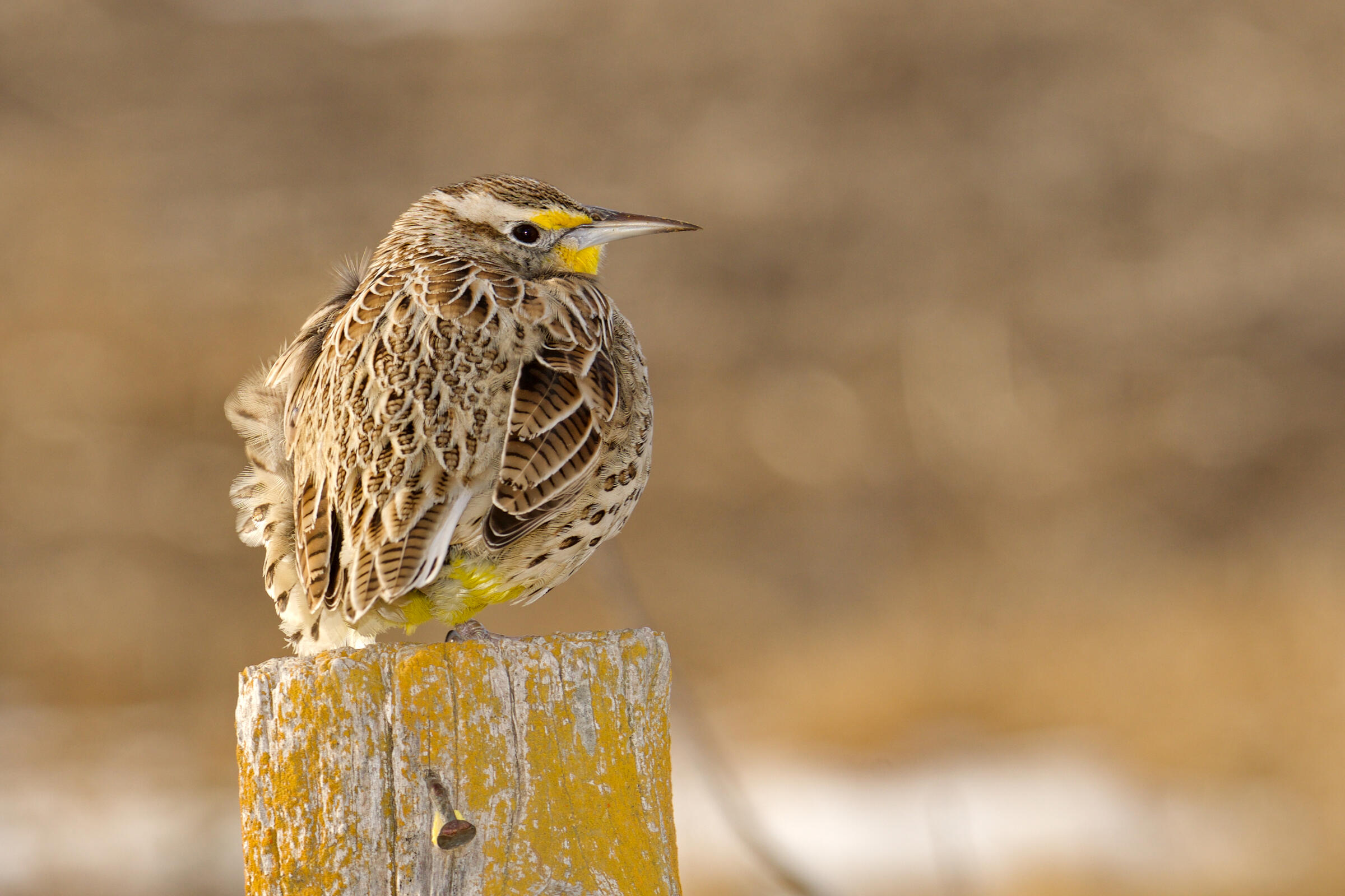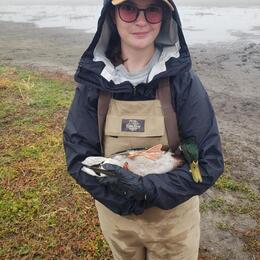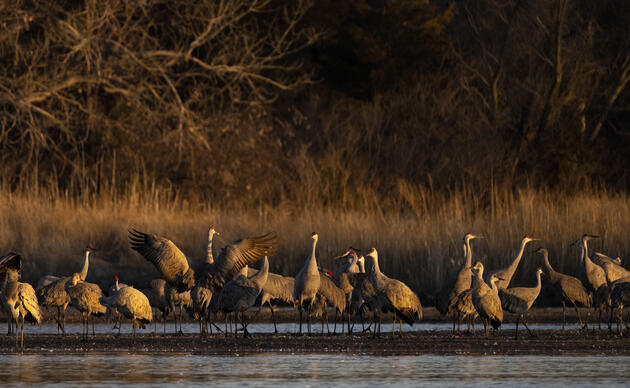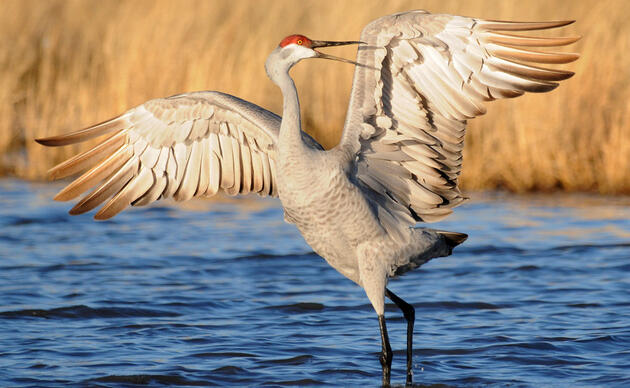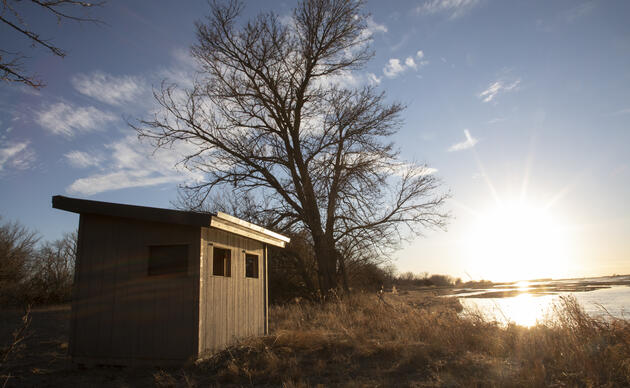Western Meadowlarks are grassland residents at Audubon’s Rowe Sanctuary. Their scientific name is Sturnella neglecta, which was assigned by John James Audubon. Audubon gave this name to the Western Meadowlark as he believed this starling-like (Sturnella) species was often disregarded (neglecta) by early explorers and settlers venturing out west. This member of the Blackbird family is the state bird of Nebraska, along with Kansas, Montana, North Dakota, Oregon, and Wyoming. The Northern cardinal is the only species to be the state bird of more states than the Western Meadowlark possessing the title in seven states rather than six.
Western Meadowlarks are stocky in figure, around 22-28 cm tall, and are often distinguished by the black V on their yellow breast. The outer tail feathers are white and most obvious during takeoff and landing. Western Meadowlarks possess a rounded wing shape along with a rounded, short, and square-tipped tail shape. They look almost indistinguishable from Eastern Meadowlarks (Sturnella magna), but the unique call of the Western Meadowlark serves as a marker between the species.
During the mating season, the song of males often fills the air. Their songs can often be described as gurgling with flute-like noises that often descend in scale. This contrasts with the Eastern Meadowlark’s song, which is a simpler series of plaintive whistles.
Western Meadowlarks can be found as year-round residents in most of the central and western portions of the United States. Their breeding range spans north into southern portions of Canada and wintering grounds throughout the northern half of Mexico. In the central portion of the United States, their range overlaps with the Eastern Meadowlark. Although this is the case, mixed species pairs are rare; in instances where few mates are available, they can produce fertile offspring, but few eggs that hatch in controlled experiments. Open grasslands, meadows, prairies, deserts, savannas, and agricultural fields serve as habitat for Western Meadowlarks, while areas that are wooded or have heavy shrub concentrations are often avoided.
Diet varies based on season. In the winter and spring months, grains are a staple of their diet. Harsh winters have been associated with eating roadkill carcasses. In the summer breeding season, when resources are available, insects are a main component of their diet. Western Meadowlarks use the “gaping” feeding behavior as they insert their beak into the soil and pry it open to reach seeds and insects like beetles, ants, and cutworms. If available, they occasionally consume eggs from other grassland bird species. Their fall diet often consists of weed seeds.
During the breeding season, males defend a territory, and a successful male will often have 1-2 mates each season. Female Western Meadowlarks select a nest site on the ground, often using an impression that are already present, like a hoof print from cattle or natural dip in the landscape. Nests are well camouflaged and constructed with grass that is woven into nearby vegetation. It can take upwards of 6-8 days for the female to build the first nest of the season with a cup size of 4-5 inches in width and 2-3 inches deep.
One to two broods are produced each year with 5-6 eggs in each clutch on average. The eggs are white with spotting of brown, rust, and lavender. The incubation period of Western Meadowlark eggs ranges from 13-16 days with a nesting period of 10-12 days. Although males are not involved with the nest building or incubation, they are observed to assist with food supply to the chicks following hatching and nest defense from predators.
Western Meadowlarks are listed in the Least Concern category of the IUCN Red List with a population size of 100,000,000. Although this is the case, the population has decreased by about 40 percent in the last 50 years, averaging about 0.9% a year, according to the North American Breeding Bird Survey. Their decline can be attributed to human-related causes, including the use of pesticides, fire suppression, and habitat loss.
May your fence posts be filled with the songs of the Western Meadowlarks this summer!
References
Western Meadowlark Life History, All about Birds, Cornell Lab of Ornithology. (n.d.). https://www.allaboutbirds.org/guide/Western_Meadowlark/lifehistory
Western Meadowlark Overview, All about birds, Cornell Lab of Ornithology. (n.d.). https://www.allaboutbirds.org/guide/Western_Meadowlark/overview
Western meadowlark. American Bird Conservancy. (2023, May 31). https://abcbirds.org/bird/western-meadowlark/
Western meadowlark. Audubon. (2024, December 7). https://www.audubon.org/field-guide/bird/western-meadowlark?_gl=1%2Ah0g8pe%2A_gcl_au%2ANzM0NTM3OTkyLjE3NDEyMDE0MTA.%2A_ga%2AMjAyNzYzMTE2MC4xNzQxMjAxNDEx%2A_ga_X2XNL2MWTT%2AczE3NDg0NTc5MTUkbzgkZzEkdDE3NDg0NTgwMzIkajEzJGwwJGgw

